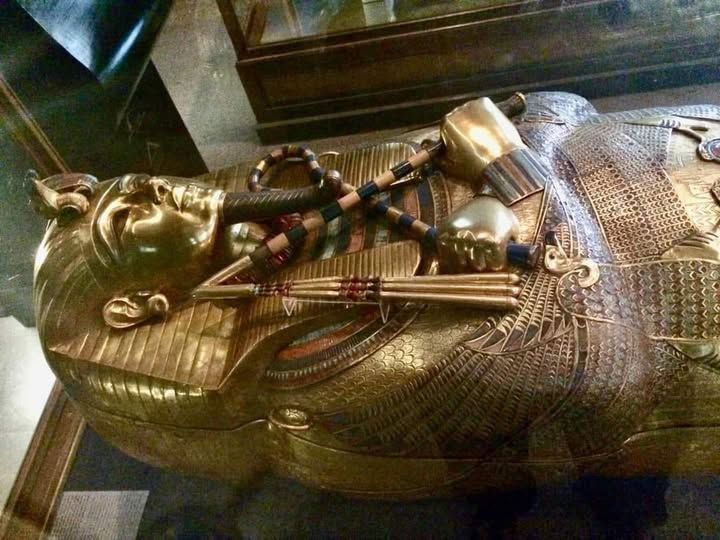The innermost coffin of Tutankhamun, crafted from solid gold, stands as one of the most significant artifacts from ancient Egypt. This extraordinary coffin is adorned with intricate decorations and inscriptions both inside and outside, bearing the names and epitaph of the young king, along with protective texts intended to safeguard him in the afterlife. Embedded with semiprecious stones and colored glass, the coffin reflects the exceptional craftsmanship of ancient Egyptian artisans, showcasing their advanced metalworking and artistic skills.

The coffin is shaped to represent Osiris, the Egyptian god of the afterlife, holding the sacred insignia: the heka scepter and the flail. These symbols signify the king’s power and divine authority. Adorning the king’s forehead are the vulture and the uraeus (rearing cobra), which were believed to protect the pharaoh from harm. The coffin’s divine beard, crafted from gold and inlaid with blue glass, further emphasizes the king’s association with the gods. This artifact, cataloged as JE 60671, is currently housed in the Egyptian Museum in Cairo, where it remains a focal point of Egyptological study and public fascination.
Measuring approximately 1.88 meters (6.2 feet) in length and weighing about 110.4 kilograms (243 pounds), the coffin was designed to protect and preserve the body of Tutankhamun, the boy king of Egypt’s 18th Dynasty. Within the coffin lay the king’s mummified body, his head covered by the iconic gold funerary mask that has become synonymous with ancient Egyptian culture. This innermost coffin is the third and final layer of a nested set of three anthropoid coffins, each designed to encase the one within, ensuring maximum protection for the king’s remains.
Following the discovery of Tutankhamun’s tomb in November 1922, the mummy was initially found within this innermost coffin. Soon after, both the inner and middle coffins were transferred to the Egyptian Museum in Cairo, while the outer gilded coffin, crafted from wood and covered in gold leaf, was left within the tomb at Thebes, now modern-day Luxor. Today, the king’s mummy rests in the outer coffin inside his tomb, which continues to attract visitors from around the world.
The story of Tutankhamun’s tomb is one that has captivated the public imagination for over a century. The discovery, led by British archaeologist Howard Carter, is often portrayed as a singular, dramatic event. However, the process of uncovering and excavating the tomb was a complex endeavor that unfolded over several months, involving meticulous planning, careful excavation, and detailed documentation. The tomb, designated KV62, is located in the Valley of the Kings on the west bank of the Nile River, an area renowned for its royal burials during the New Kingdom period.
The burial chamber, measuring approximately 6 meters by 4 meters (20 feet by 13 feet), housed the king’s rectangular quartzite sarcophagus, whose four corners are adorned with protective figures of the four sons of Horus. With their outspread wings, these deities were believed to safeguard the king’s body, ensuring his safe passage into the afterlife. Nestled within the sarcophagus were the three anthropoid coffins, each depicting the king in the Osirian position, symbolizing his transformation into a god. This layered arrangement reflected ancient Egyptian beliefs regarding the afterlife, where physical protection and spiritual symbolism were paramount.
The innermost gold coffin is a testament to the artistry and religious devotion of ancient Egypt. Its surface is covered with intricate hieroglyphs and symbolic motifs that convey prayers, spells, and protective incantations from the ancient Egyptian Book of the Dead. These inscriptions were intended to guide the deceased through the perilous journey of the afterlife, ensuring their resurrection and eternal life among the gods. The use of gold, a metal associated with the flesh of the gods, underscored the king’s divine status and his enduring connection to the sun god Ra.
The discovery of Tutankhamun’s tomb and its treasures was a milestone in the history of archaeology. For the first time, the world was able to glimpse the wealth and splendor of an ancient Egyptian royal burial that had remained largely intact for over three millennia. The tomb’s artifacts provided invaluable insights into the art, culture, and beliefs of the New Kingdom period, revealing the sophistication and complexity of ancient Egyptian society. Among the most iconic finds was the gold funerary mask, which has since become a symbol of ancient Egypt itself.
Howard Carter’s meticulous documentation of the excavation process helped to preserve the context and significance of each artifact. Photographs taken by Harry Burton, the official photographer of the excavation, captured every stage of the discovery, from the first glimpse of the sealed doorway to the removal of the final artifacts. These images, along with Carter’s detailed notes, continue to serve as essential resources for researchers studying the tomb and its contents.
Despite the excitement surrounding the discovery, the excavation also highlighted the colonial dynamics that characterized archaeology in the early 20th century. Carter’s accounts often minimized the contributions of his Egyptian collaborators, such as Ra’is Ahmed and the local workforce who played a crucial role in the excavation process. This oversight reflects the broader context of colonial archaeology, where local knowledge and labor were frequently undervalued. Nevertheless, the discovery of Tutankhamun’s tomb remains a landmark event that transformed our understanding of ancient Egypt.
The innermost gold coffin of Tutankhamun continues to be celebrated for its artistic and historical significance. Its exquisite craftsmanship, combined with its cultural and religious symbolism, makes it one of the most important artifacts ever discovered. As a masterpiece of ancient Egyptian art, it serves as a tangible link to the past, offering a glimpse into the beliefs and practices that shaped the lives of the pharaohs.
Today, visitors to the Egyptian Museum in Cairo can marvel at this remarkable artifact, standing in awe of the skill and creativity that brought it to life. The coffin’s enduring beauty and the story of its discovery continue to inspire fascination and wonder, ensuring that the legacy of Tutankhamun, the Golden Pharaoh, will endure for generations to come.





